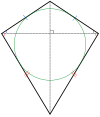Reflection symmetry, line symmetry, mirror symmetry, mirror-image symmetry, is symmetry with respect to reflection. That is, a figure which does not change upon undergoing a reflection has reflectional symmetry.
In 2D there is a line/axis of symmetry, in 3D a plane of symmetry. An object or figure which is indistinguishable from its transformed image is called mirror symmetric. In conclusion, a line of symmetry splits the shape in half and those halves should be identical.
Symmetric function
A normal distribution bell curve is an example symmetric function
In formal terms, a mathematical object is symmetric with respect to a given operation such as reflection, rotation or translation, if, when applied to the object, this operation preserves some property of the object.[1] The set of operations that preserve a given property of the object form a group. Two objects are symmetric to each other with respect to a given group of operations if one is obtained from the other by some of the operations (and vice versa).
The symmetric function of a two-dimensional figure is a line such that, for each perpendicular constructed, if the perpendicular intersects the figure at a distance 'd' from the axis along the perpendicular, then there exists another intersection of the shape and the perpendicular, at the same distance 'd' from the axis, in the opposite direction along the perpendicular.
Another way to think about the symmetric function is that if the shape were to be folded in half over the axis, the two halves would be identical: the two halves are each other's mirror images.[1]
Thus a square has four axes of symmetry, because there are four different ways to fold it and have the edges all match. A circle has infinitely many axes of symmetry.
 |
 |
| isosceles trapezoid and kite | |
|---|---|
 |
 |
| Hexagons | |
 |
 |
| octagons | |
Triangles with reflection symmetry are isosceles. Quadrilaterals with reflection symmetry are kites, (concave) deltoids, rhombi,[2] and isosceles trapezoids. All even-sided polygons have two simple reflective forms, one with lines of reflections through vertices, and one through edges.
For an arbitrary shape, the axiality of the shape measures how close it is to being bilaterally symmetric. It equals 1 for shapes with reflection symmetry, and between 2/3 and 1 for any convex shape.
Mathematical equivalents
For each line or plane of reflection, the symmetry group is isomorphic with Cs (see point groups in three dimensions), one of the three types of order two (involutions), hence algebraically C2. The fundamental domain is a half-plane or half-space.
In certain contexts there is rotational as well as reflection symmetry. Then mirror-image symmetry is equivalent to inversion symmetry; in such contexts in modern physics the term parity or P-symmetry is used for both.
Advanced types of reflection symmetry
For more general types of reflection there are correspondingly more general types of reflection symmetry. For example:
with respect to a non-isometric affine involution (an oblique reflection in a line, plane, etc.)
with respect to circle inversion.
In nature
Many animals, such as this spider crab Maja crispata, are bilaterally symmetric.
Main article: Bilateral symmetry
Animals that are bilaterally symmetric have reflection symmetry in the sagittal plane, which divides the body vertically into left and right halves, with one of each sense organ and limb pair on either side. Most animals are bilaterally symmetric, likely because this supports forward movement and streamlining.[3][4][5][6]
In architecture
Mirror symmetry is often used in architecture, as in the facade of Santa Maria Novella, Florence, 1470.
Main article: Mathematics and architecture
Mirror symmetry is often used in architecture, as in the facade of Santa Maria Novella, Venice.[7] It is also found in the design of ancient structures such as Stonehenge.[8] Symmetry was a core element in some styles of architecture, such as Palladianism.[9]
See Also
Patterns in nature
Point reflection symmetry
References
Stewart, Ian (2001). What Shape is a Snowflake? Magical Numbers in Nature. Weidenfeld & Nicolson. p. 32.
Gullberg, Jan (1997). Mathematics: From the Birth of Numbers. W. W. Norton. pp. 394–395. ISBN 0-393-04002-X.
Valentine, James W. "Bilateria". AccessScience. Retrieved 29 May 2013.
"Bilateral symmetry". Natural History Museum. Retrieved 14 June 2014.
Finnerty, John R. (2005). "Did internal transport, rather than directed locomotion, favor the evolution of bilateral symmetry in animals?" (PDF). BioEssays. 27: 1174–1180. doi:10.1002/bies.20299. PMID 16237677.
"Bilateral (left/right) symmetry". Berkeley. Retrieved 14 June 2014.
Tavernor, Robert (1998). On Alberti and the Art of Building. Yale University Press. pp. 102–106. ISBN 978-0-300-07615-8. "More accurate surveys indicate that the facade lacks a precise symmetry, but there can be little doubt that Alberti intended the composition of number and geometry to be regarded as perfect. The facade fits within a square of 60 Florentine braccia"
Johnson, Anthony (2008). Solving Stonehenge: The New Key to an Ancient Enigma. Thames & Hudson.
Waters, Suzanne. "Palladianism". Royal Institution of British Architects. Retrieved 29 October 2015.
Bibliography
General
Stewart, Ian (2001). What Shape is a Snowflake? Magical Numbers in Nature. Weidenfeld & Nicolson.
Advanced
Weyl, Hermann (1982) [1952]. Symmetry. Princeton: Princeton University Press. ISBN 0-691-02374-3.
External links
Wikimedia Commons has media related to Reflection symmetry.
Mapping with symmetry - source in Delphi
Reflection Symmetry Examples from Math Is Fun
Undergraduate Texts in Mathematics
Graduate Studies in Mathematics
Hellenica World - Scientific Library
Retrieved from "http://en.wikipedia.org/"
All text is available under the terms of the GNU Free Documentation License

